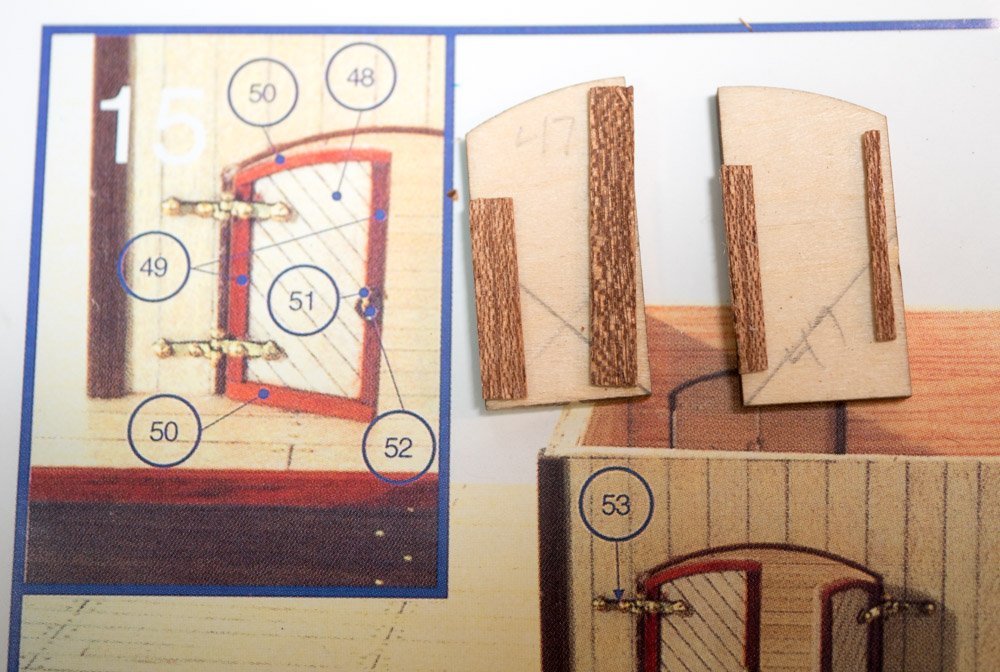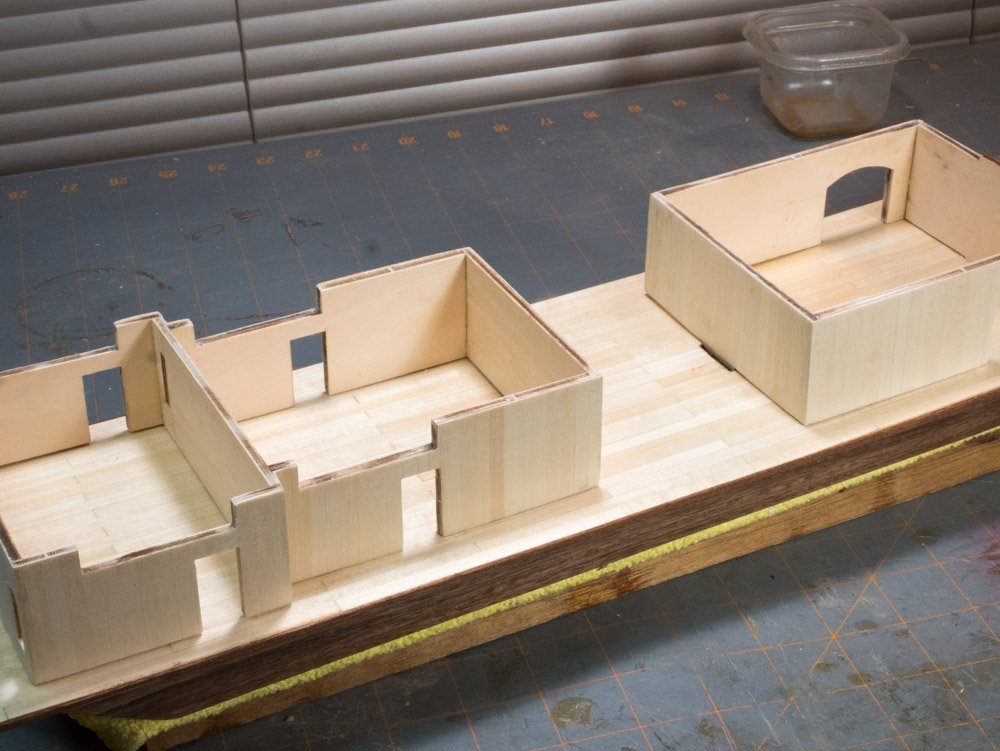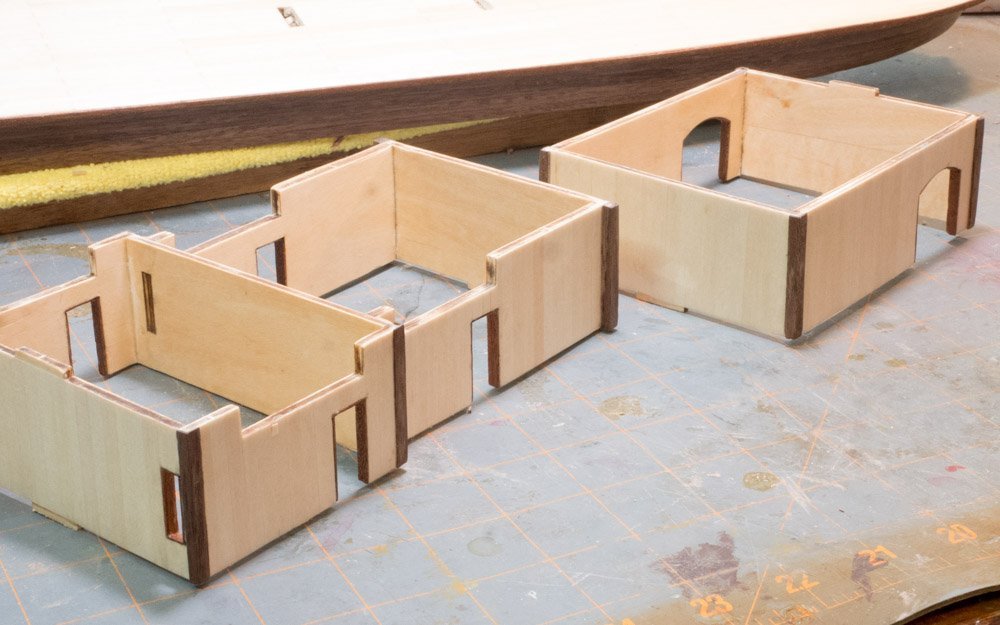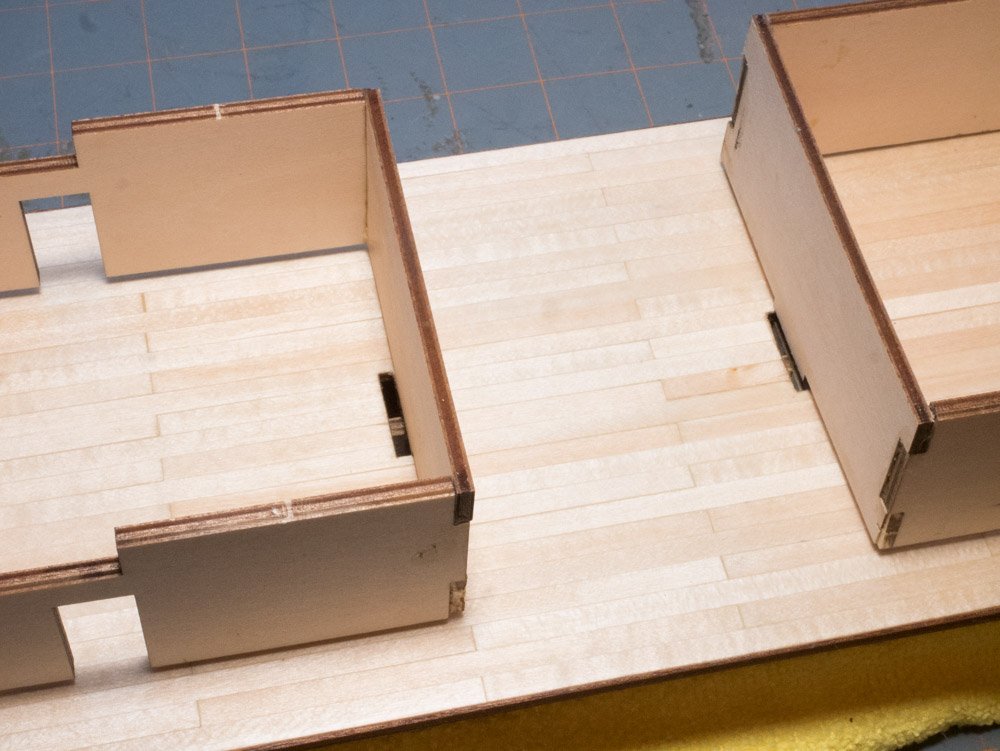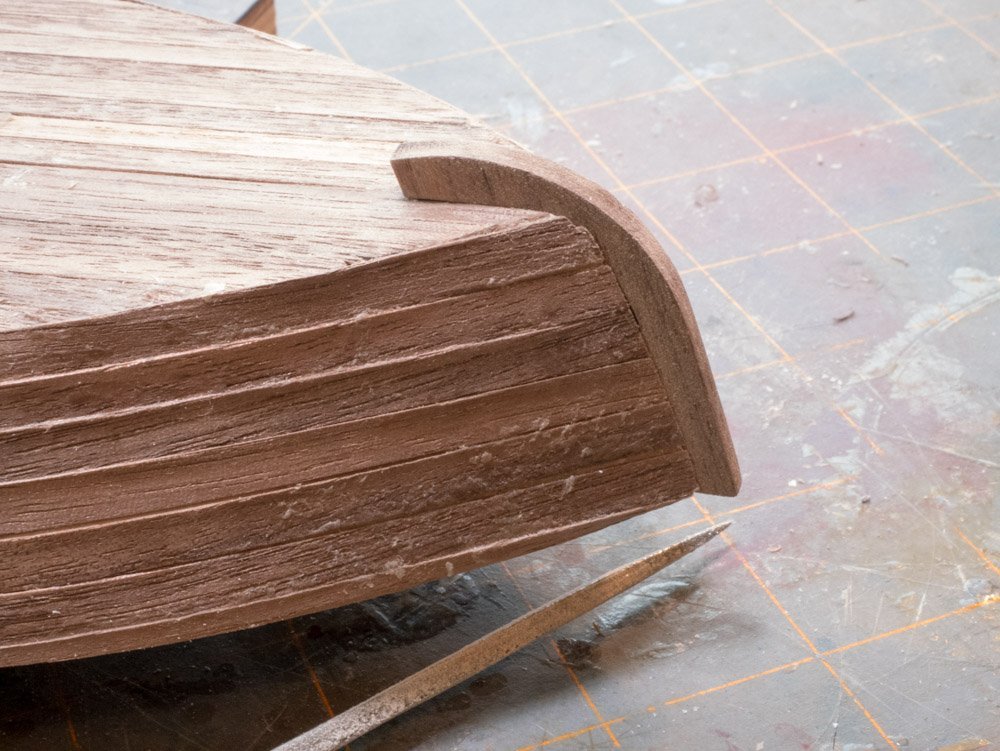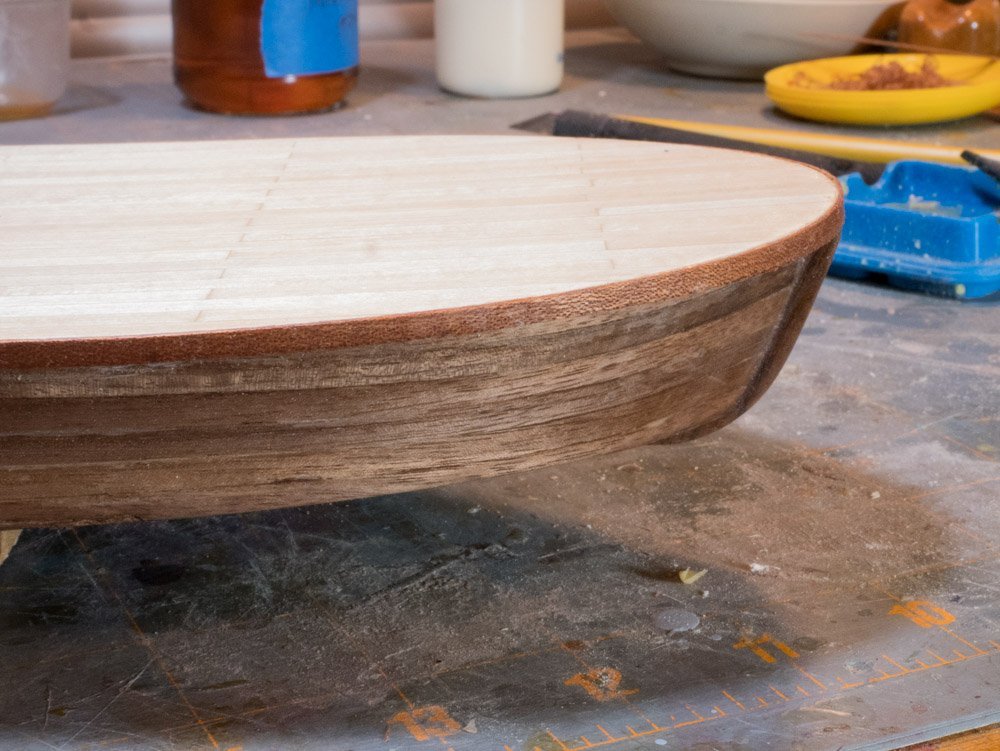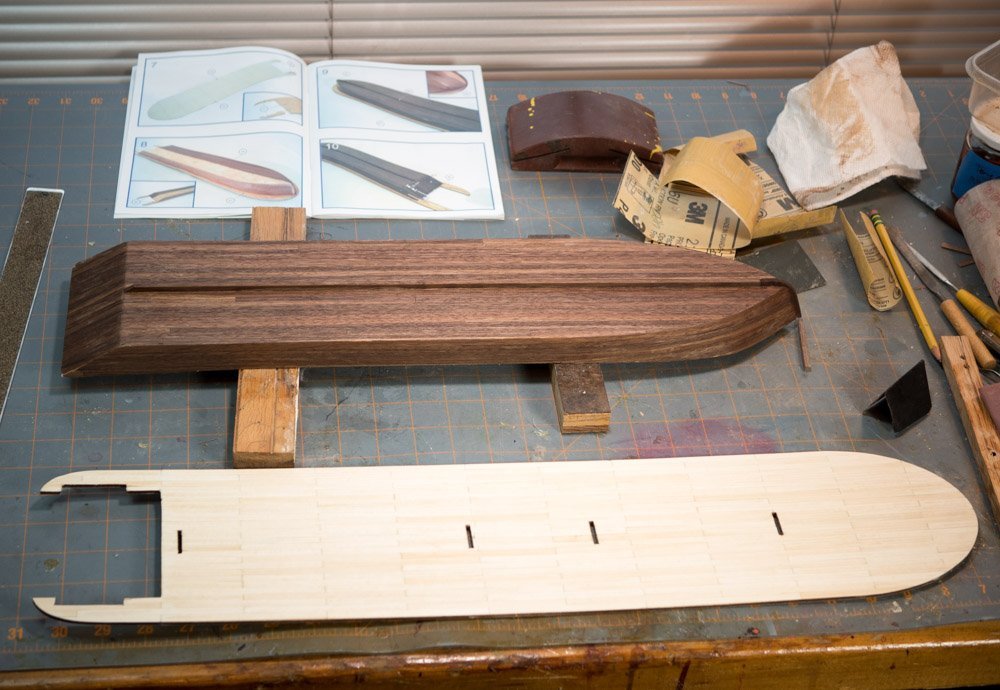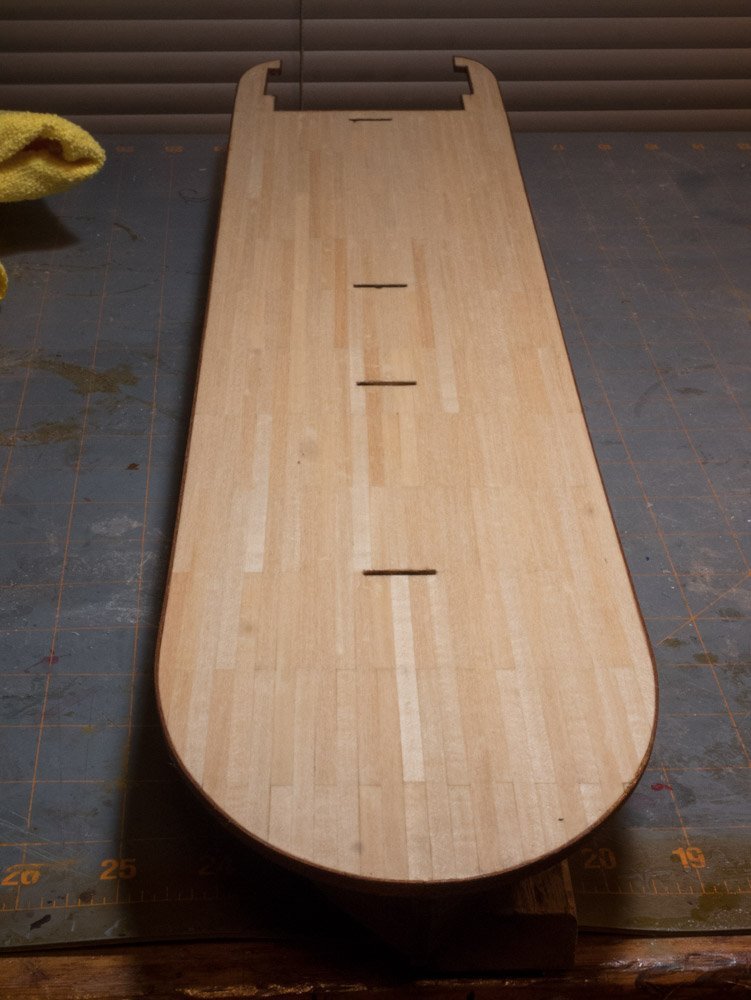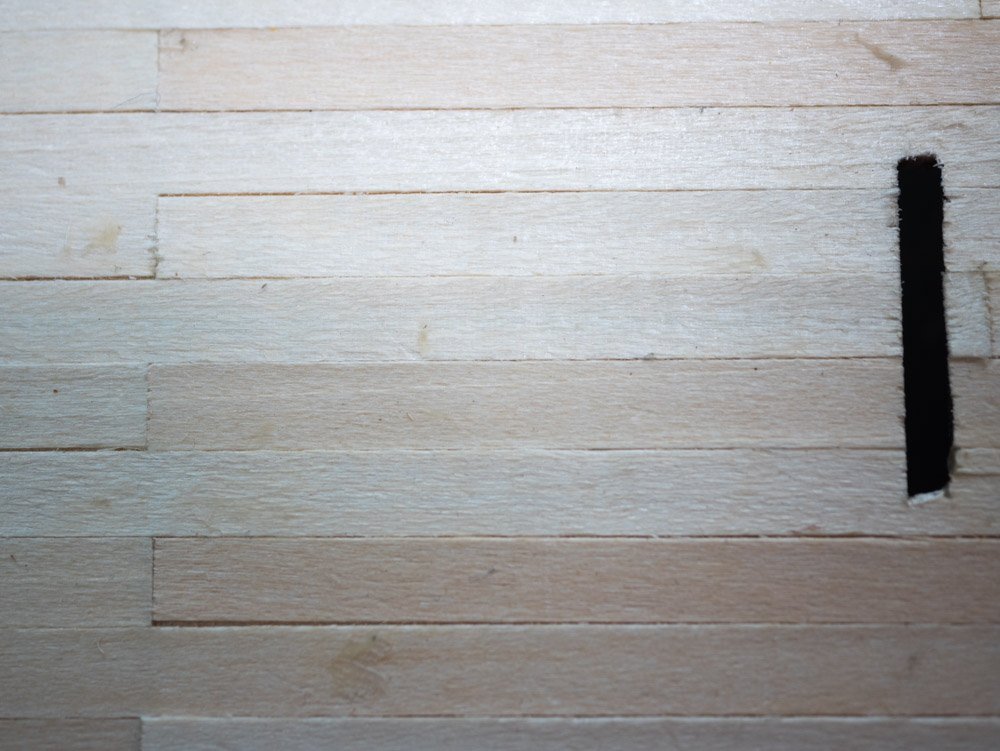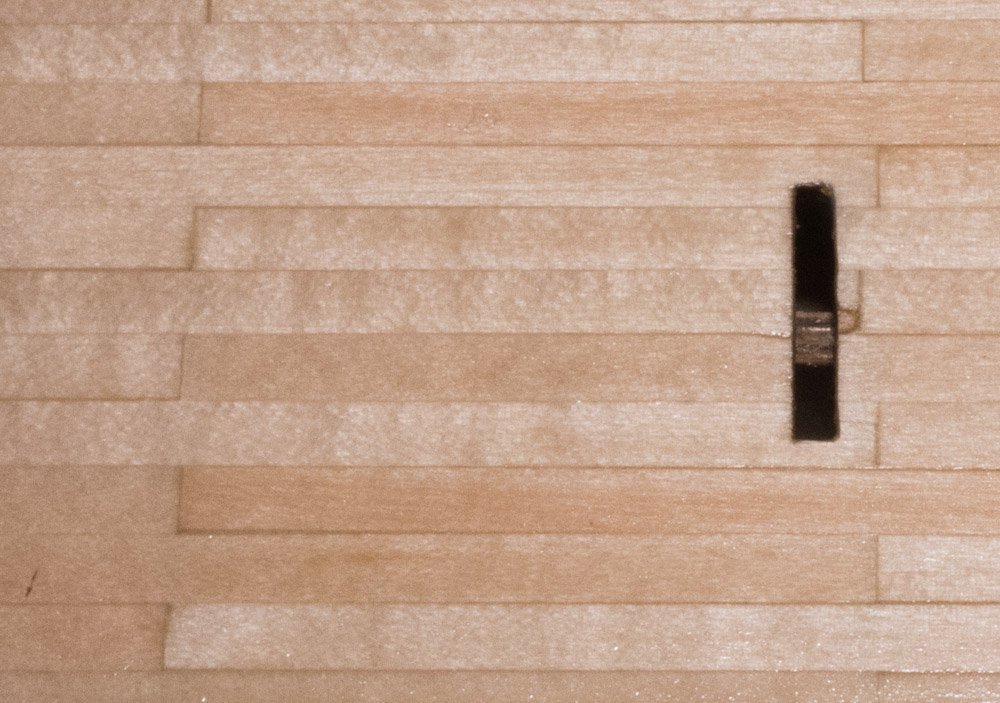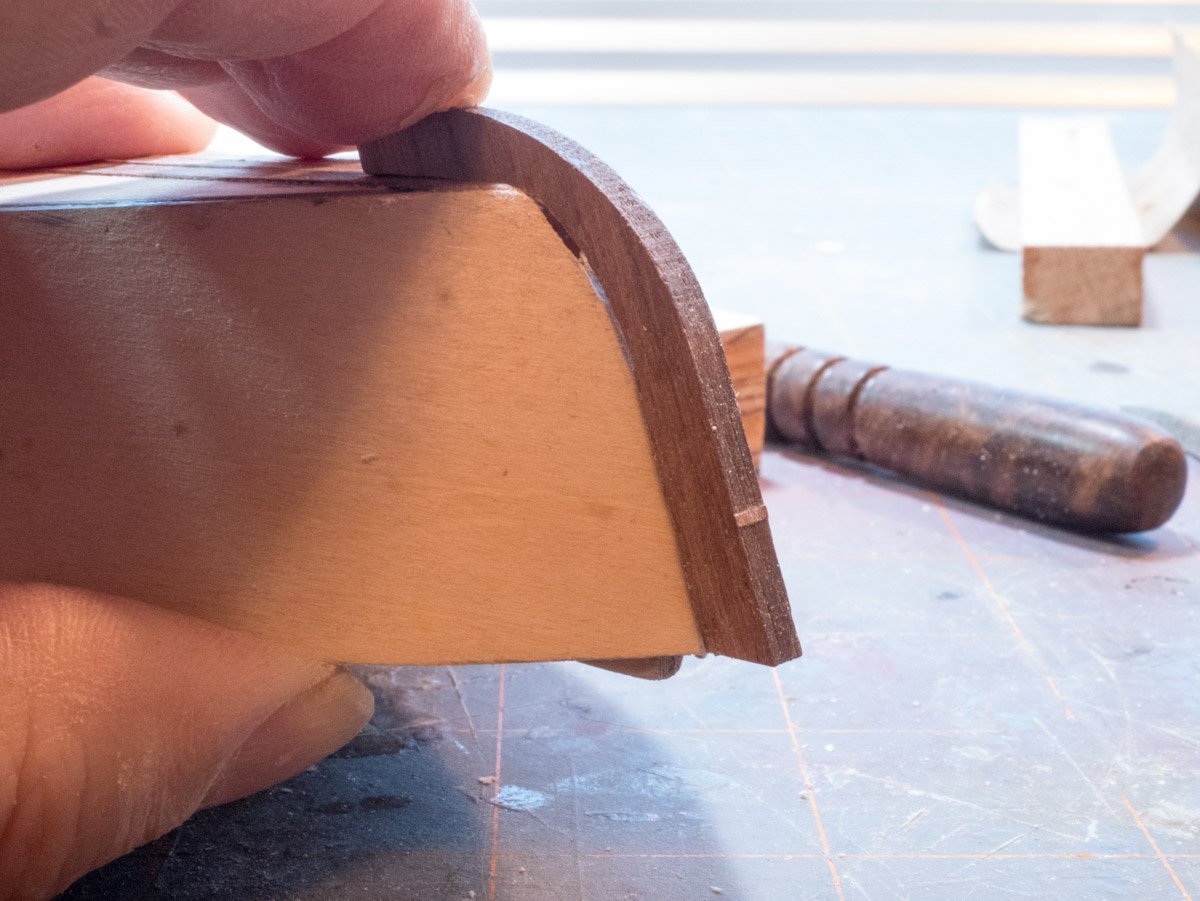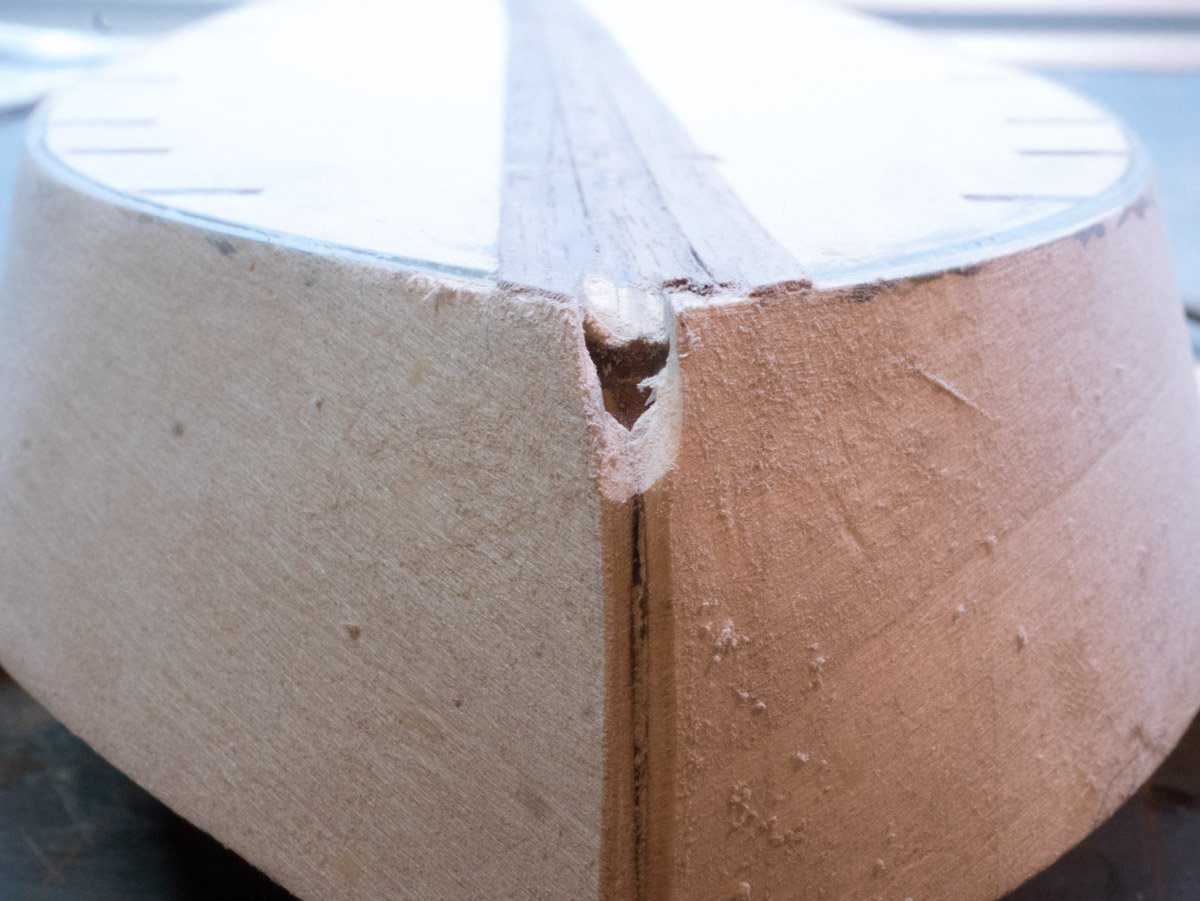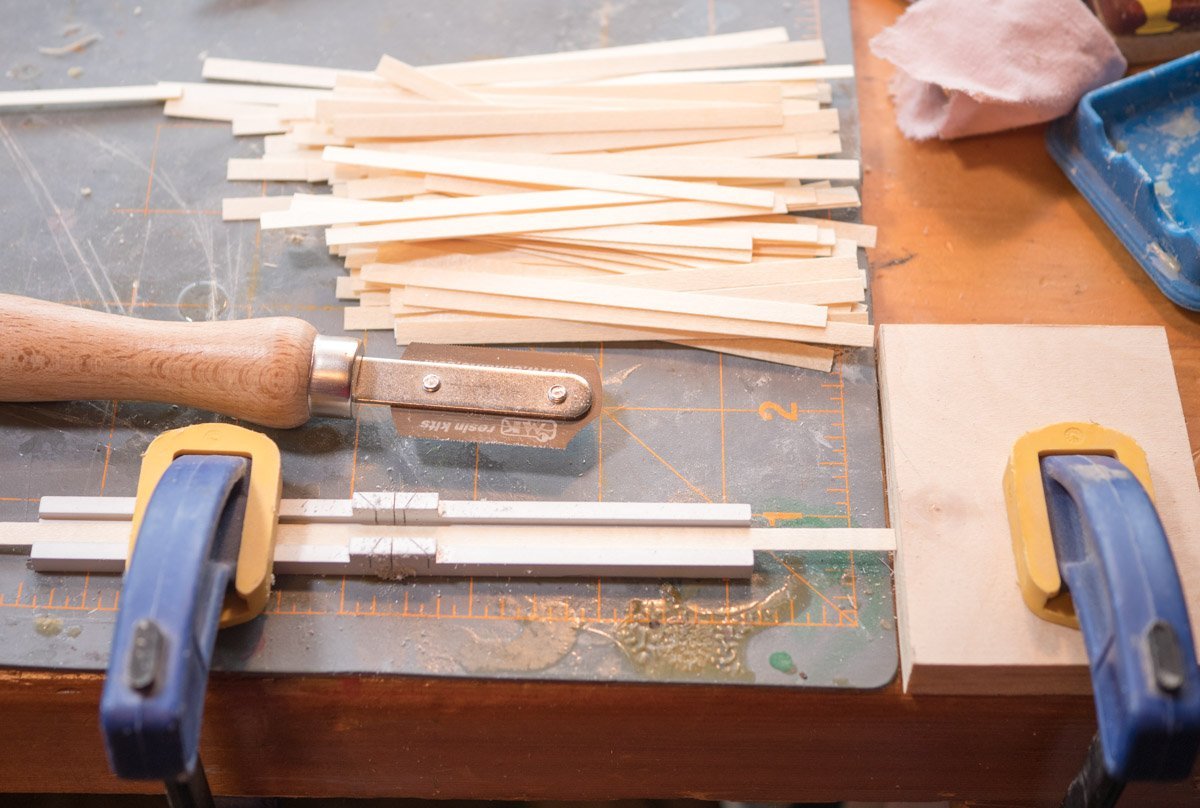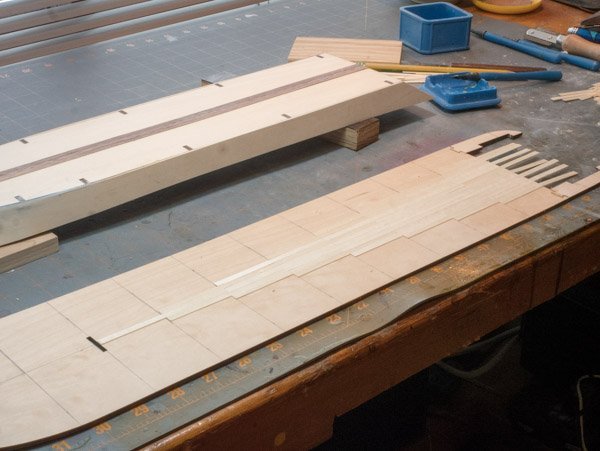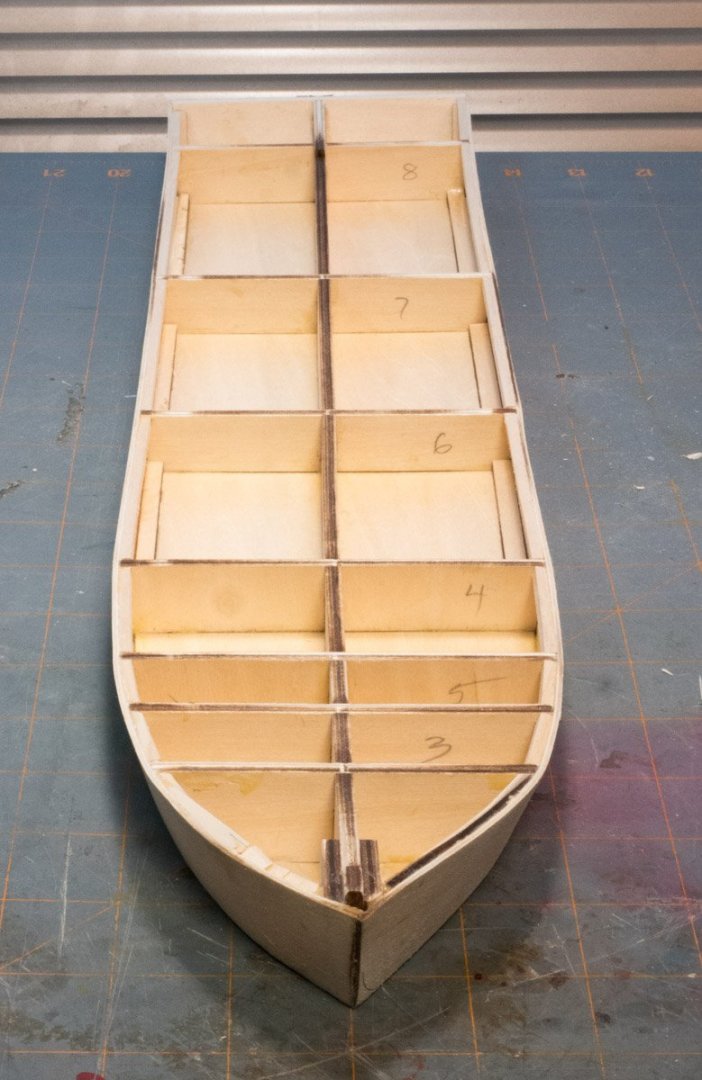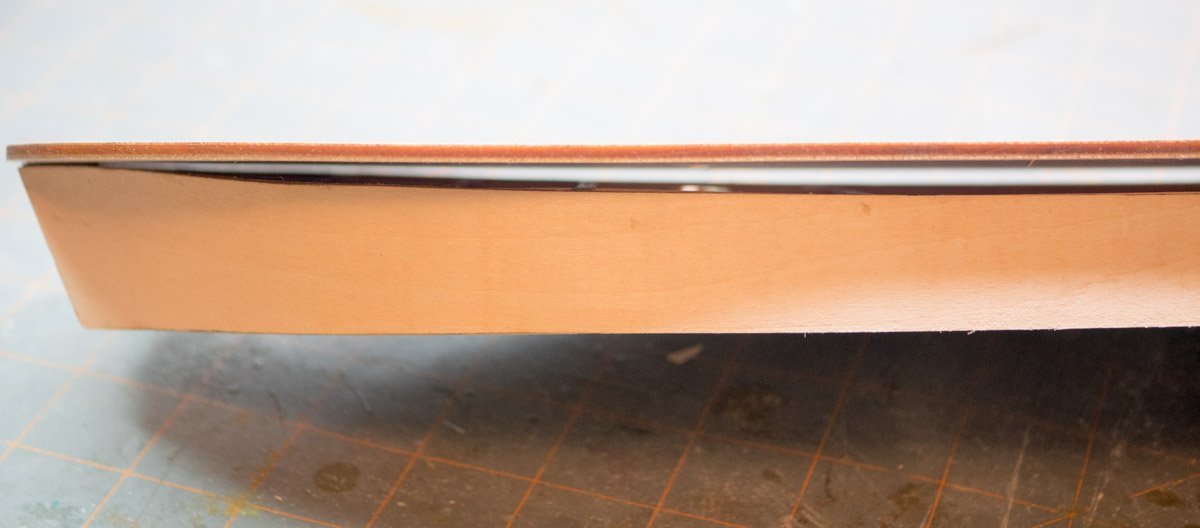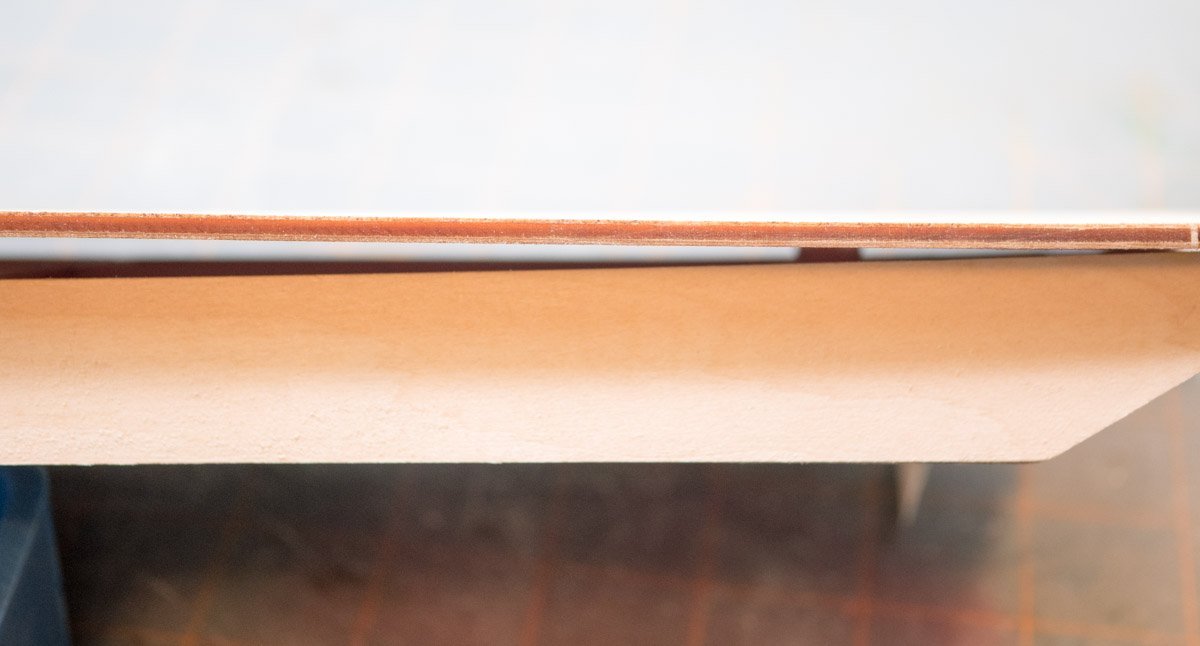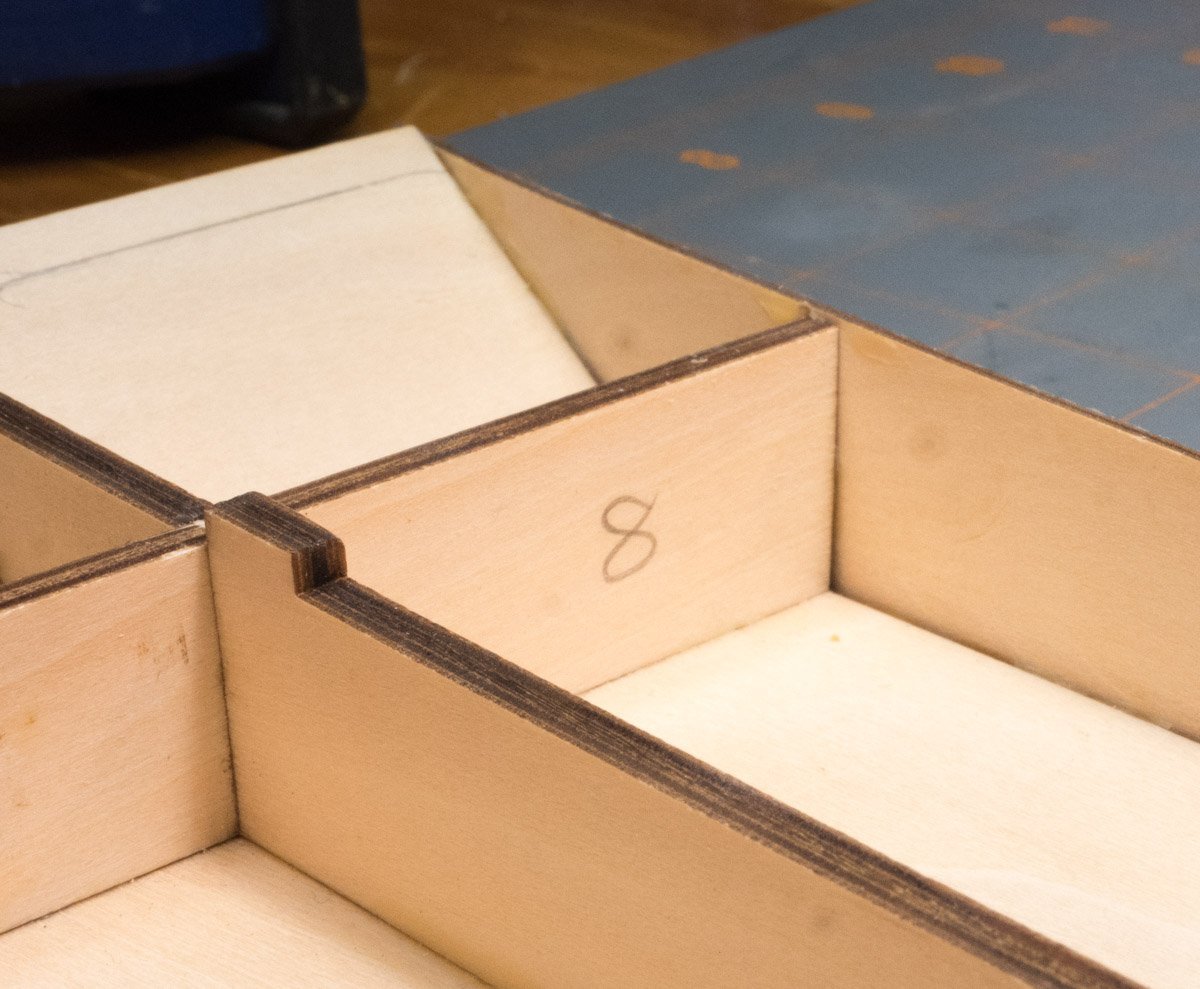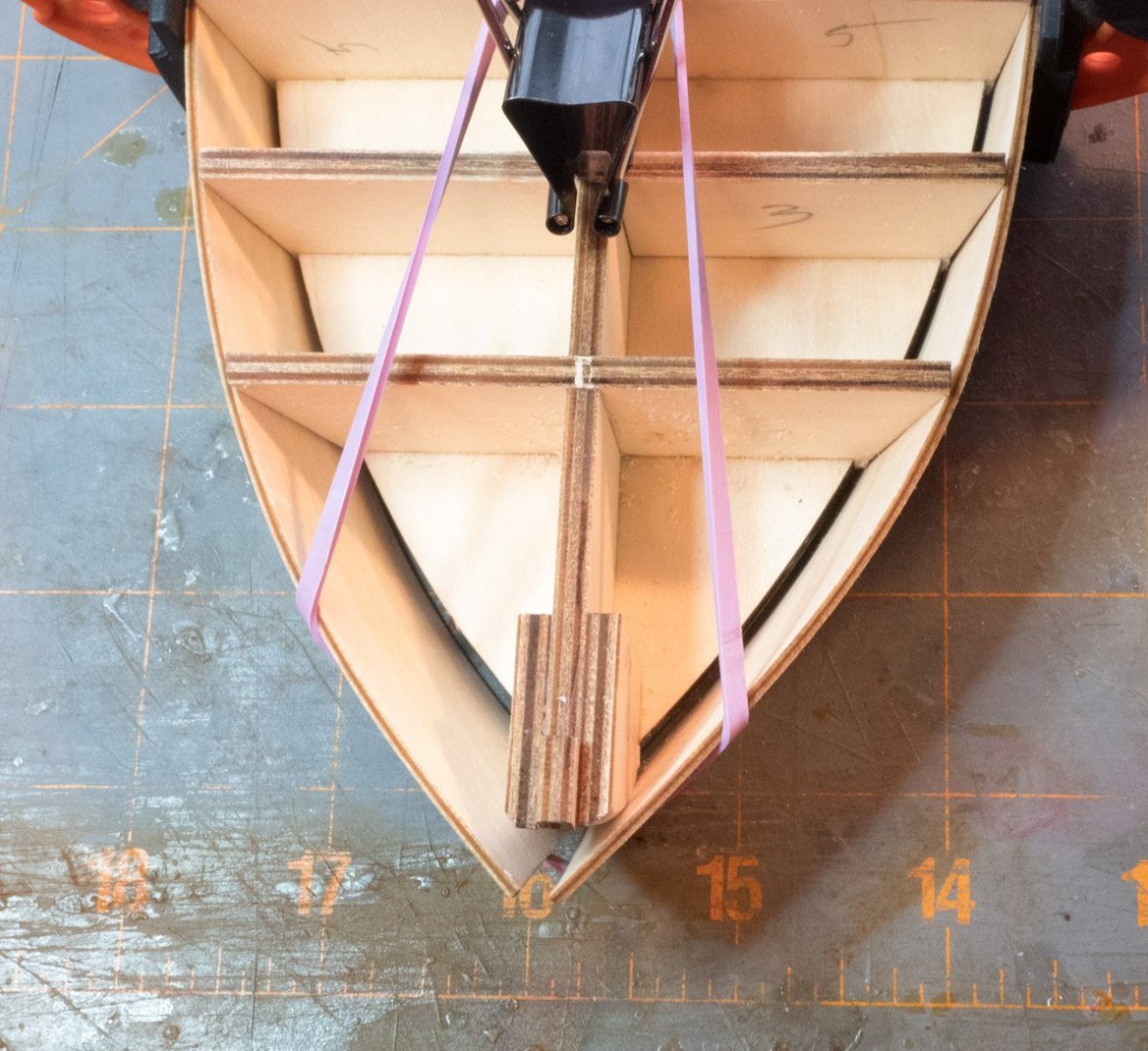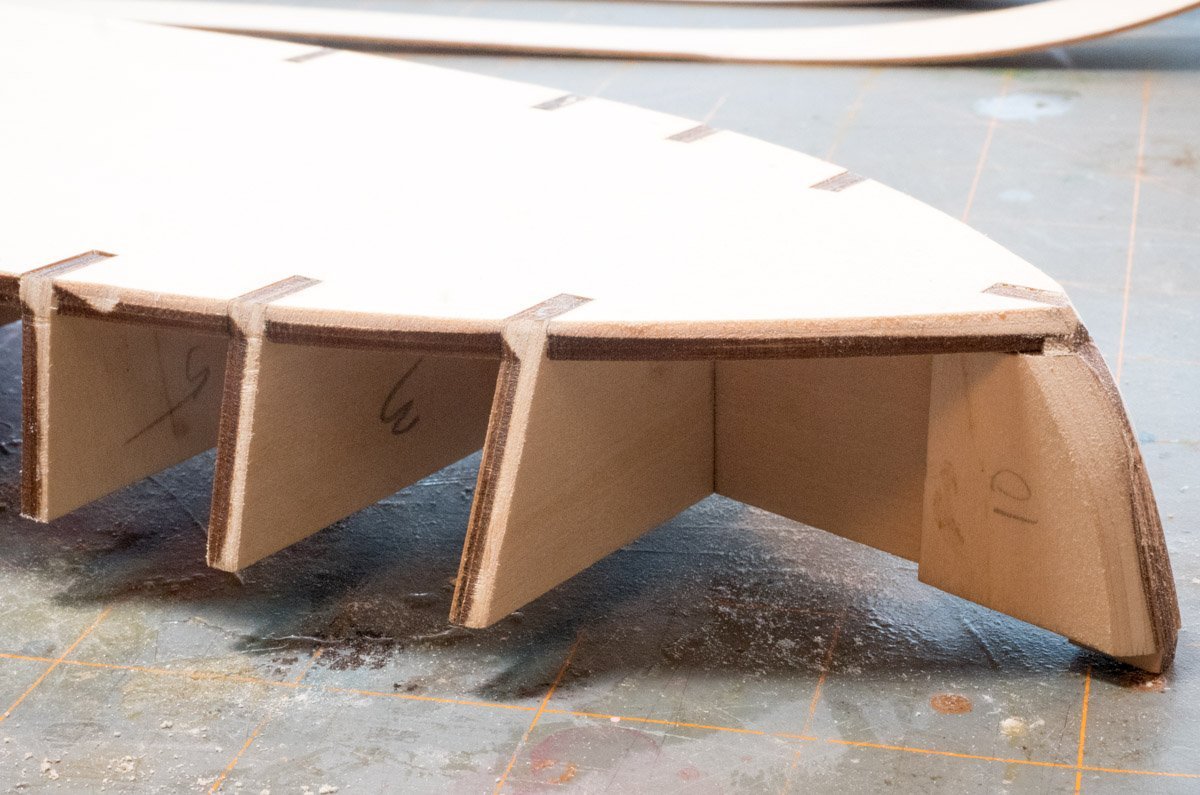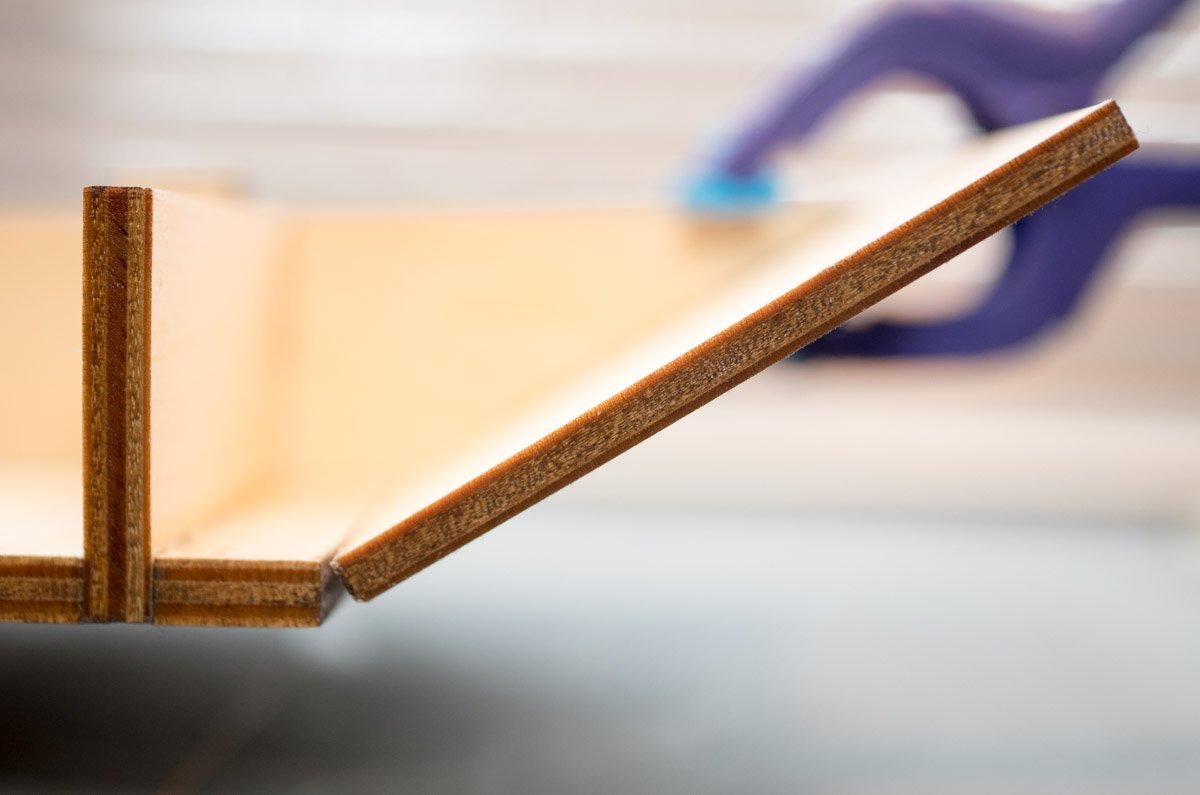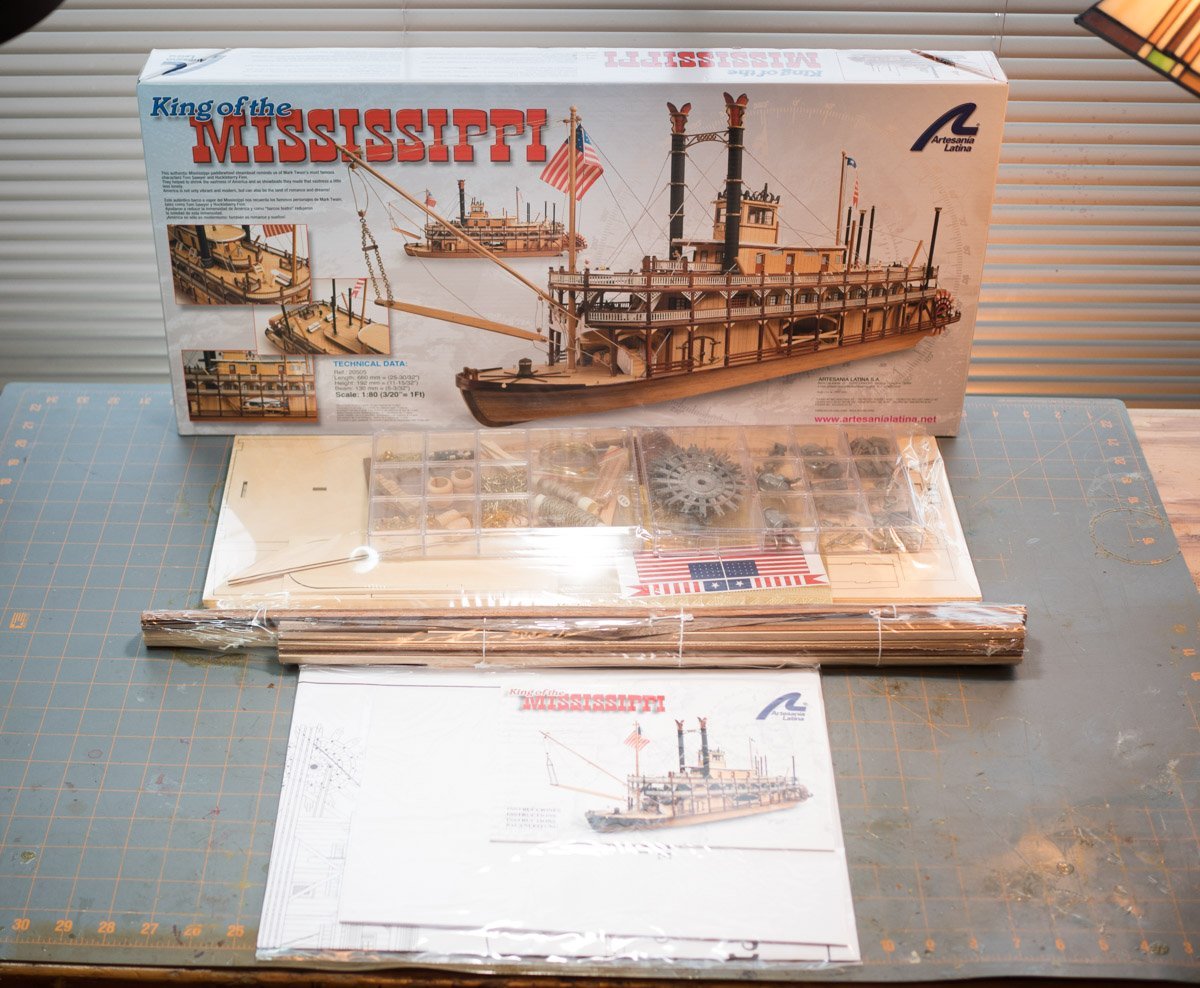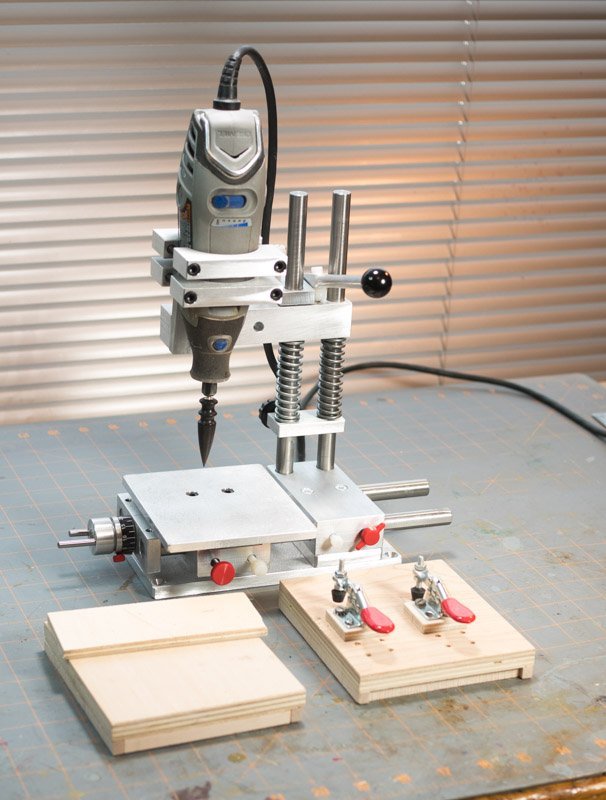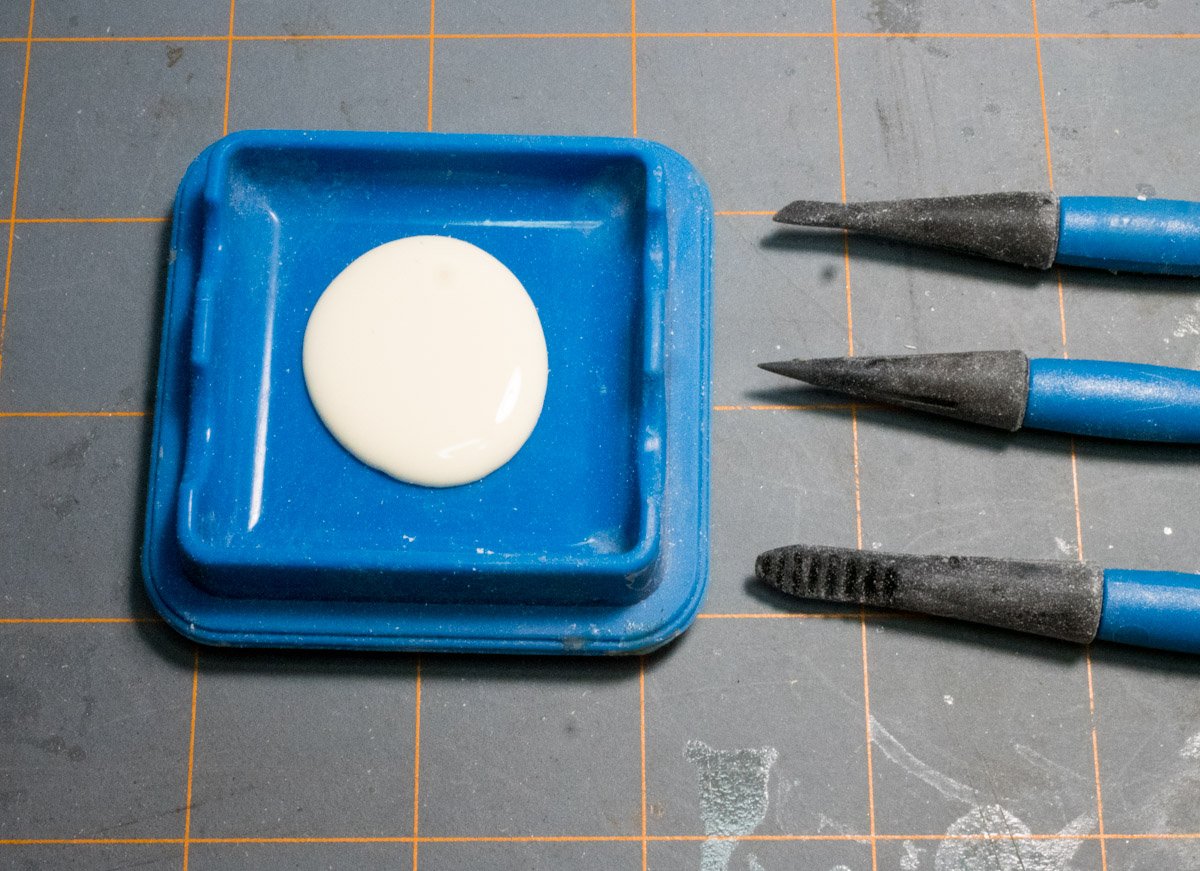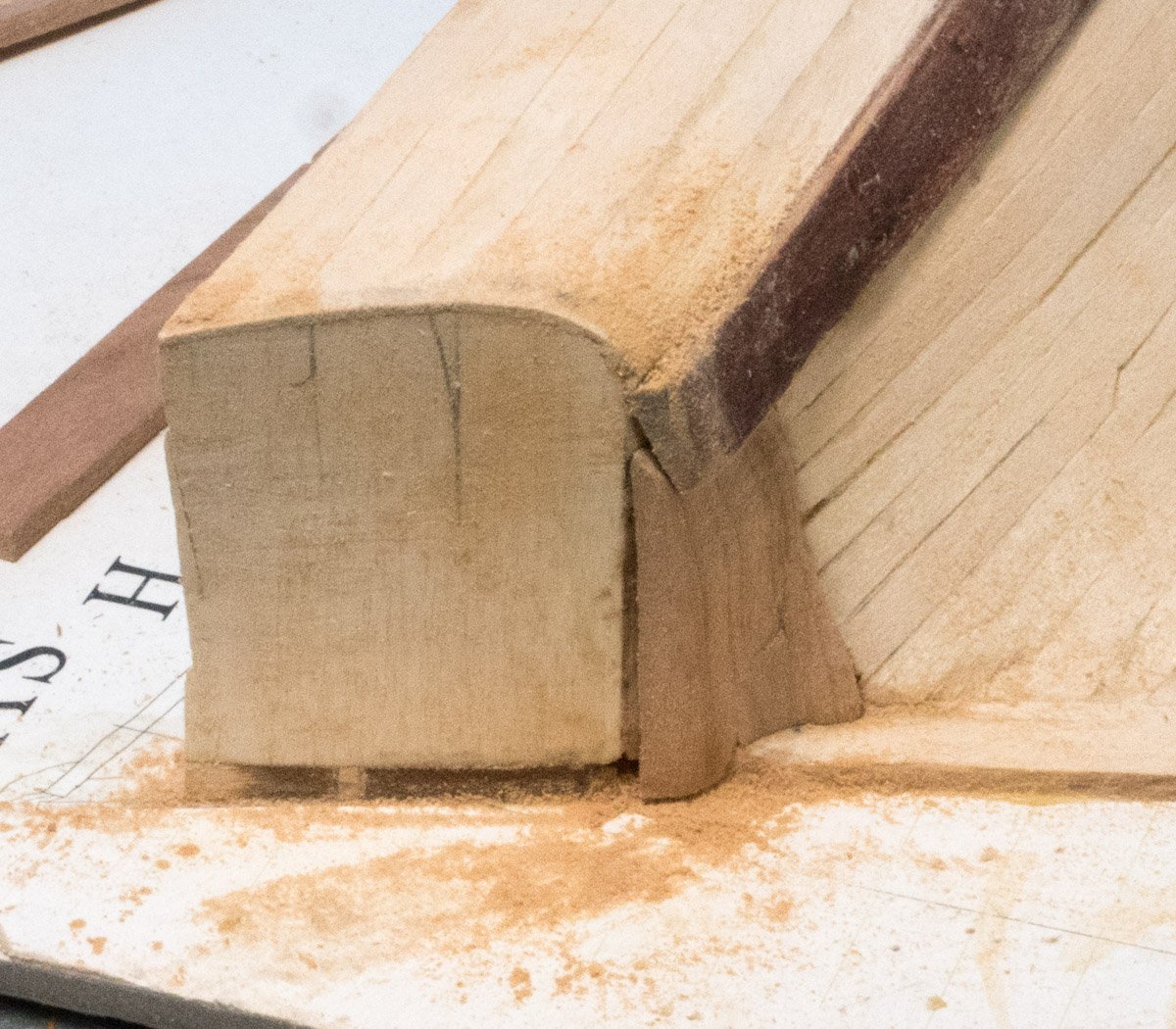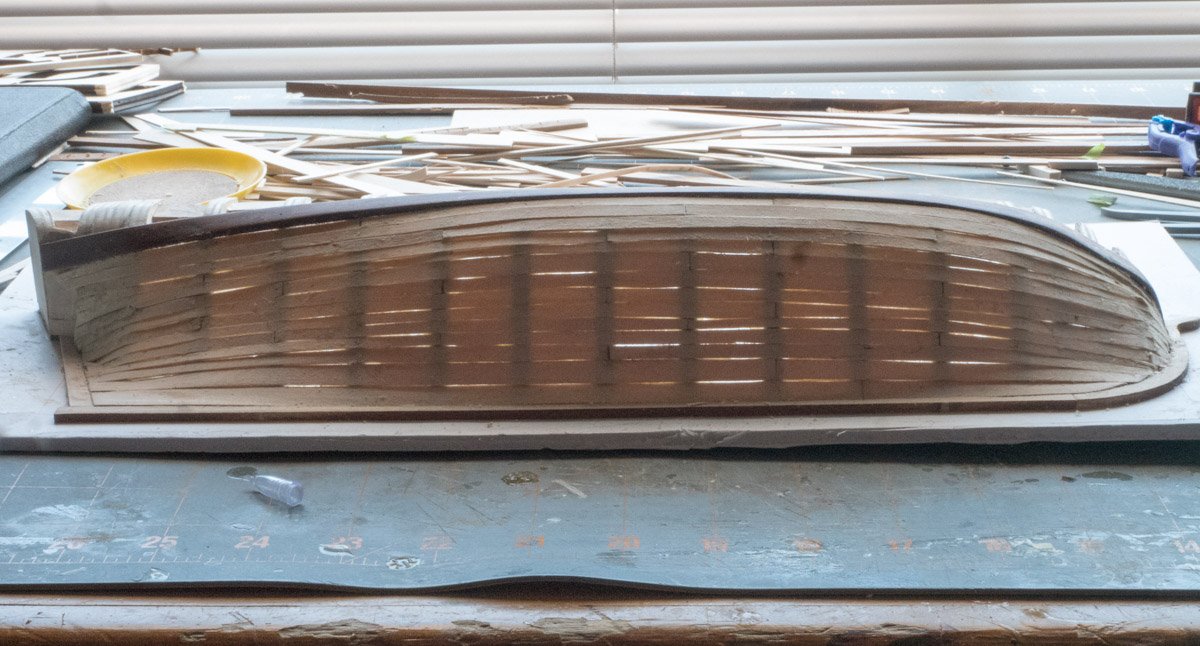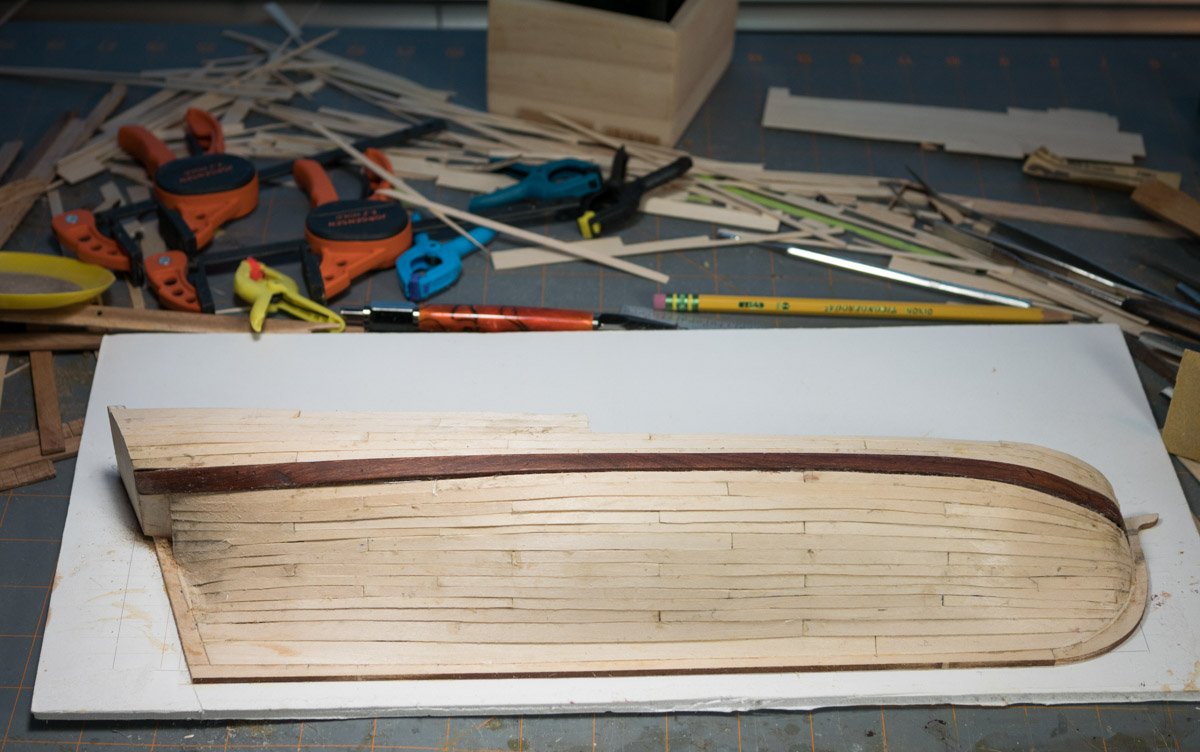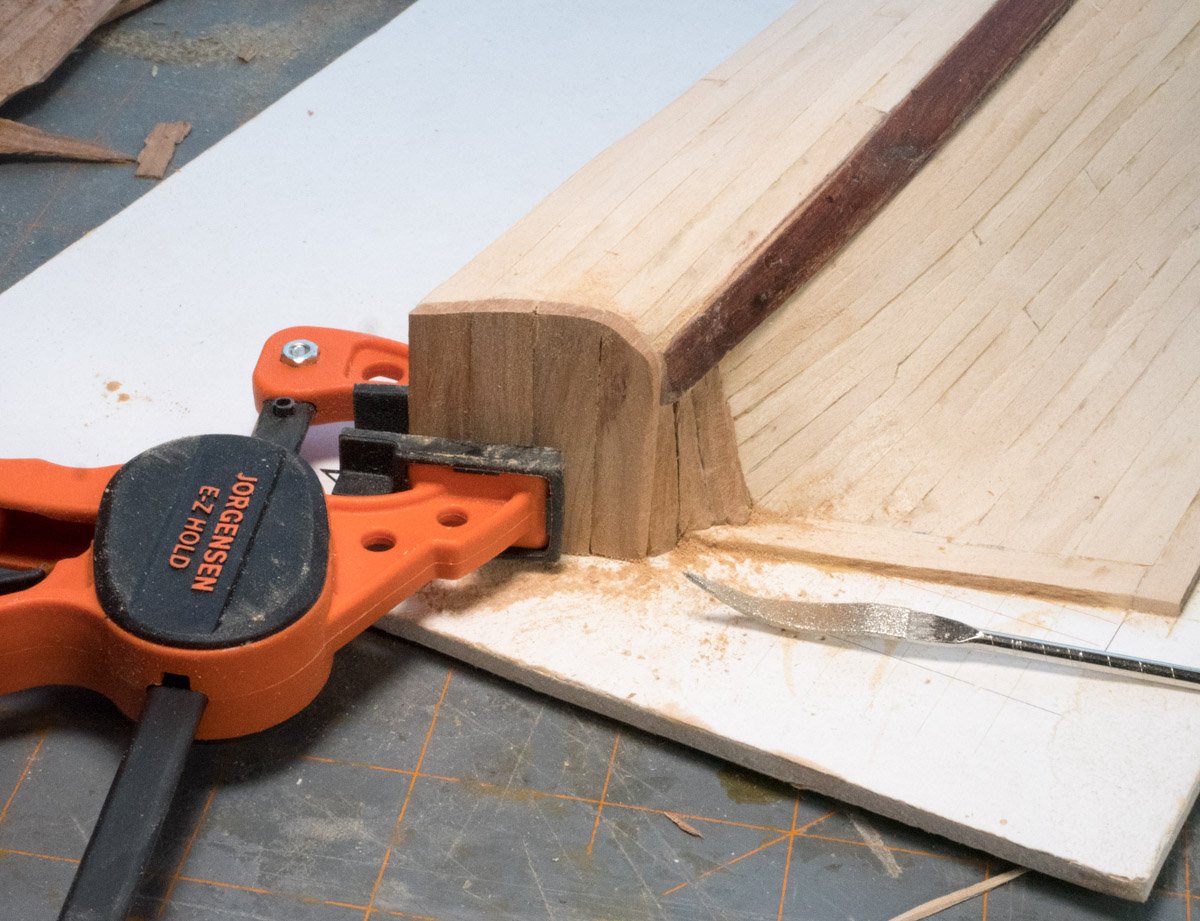-
Posts
202 -
Joined
-
Last visited
Content Type
Profiles
Forums
Gallery
Events
Everything posted by Cleat
-
I'm scoping out how to make the doors. The instructions call for the planking and trim wood with the stock sizes of the kit but the pictures look like the wood used is about half the width of the wood included with the kit. I tried cutting a piece of scrap but I don't know how to make uniform pieces (as shown in the right door). The left door shows the stock wood width.
- 132 replies
-
- King of the Mississippi
- Artesania Latina
-
(and 1 more)
Tagged with:
-
I'm making progress. I've assembled the first deck structures and planked the exterior. I've noticed in other builds that the vertical lines of the planks are highlighted, I'm wondering how they did that (and whether I want to do it). I also wonder what I want to do about the empty tab slot of the forward structure. I've added the structure corner accents and a light coat of wipe on finish.
- 132 replies
-
- King of the Mississippi
- Artesania Latina
-
(and 1 more)
Tagged with:
-
I forgot about the large drawing, it is folded up because I don't have anywhere to display it. It is a pretty detailed drawing (I need to remember to reference it more). I test fit the second deck to see which tabs work.
- 132 replies
-
- King of the Mississippi
- Artesania Latina
-
(and 1 more)
Tagged with:
-

Air brush vs paint & brush
Cleat replied to jefferyt's topic in Painting, finishing and weathering products and techniques
I'm learning how to air brush. I spent $90 for an airbrush, $100 for a compressor (with tank), and $25 for a 6-pack of paint and cleaning fluid. It takes a lot of time to learn and there are a number of variables to figure out. It takes time to clean which is a chore. I'm still getting used to it; I've only mastered full on and I'm still practicing the art of small finger movements to adjust the amount of paint. I use my airbrush more like a can of spray paint. I decided to get an airbrush with a pistol style trigger because I prefer that feel over the top button. I'm getting a lot of practice cleaning the airbrush and I still practice dots and daggers (beginner exercises). I see how useful an airbrush can be but it is a skill that takes a lot of time to learn. While I'm learning I have gotten good results on projects that didn't require precision. -
Bummer When I test fitted the first room structure, I discovered what Jeff5115 identified. One of deck slots doesn’t align with a structure tab. I did the other structure and it has the same problem. It is another challenge to solve. Hindsight Tip Construct a structure before cutting the deck slots to determine if the slots match the tabs.
- 132 replies
-
- King of the Mississippi
- Artesania Latina
-
(and 1 more)
Tagged with:
-
I don't know how the shingling happened when I glued the hull planks: I managed to sand through the edges without going through the thin planks.
- 132 replies
-
- King of the Mississippi
- Artesania Latina
-
(and 1 more)
Tagged with:
-
I finished the hull with Minwax Wipe-On Poly (clear/satin). I finished the deck with Watco tung oil thinned with mineral spirits (50/50). I wanted the deck to look more polished than the hull.
- 132 replies
-
- King of the Mississippi
- Artesania Latina
-
(and 1 more)
Tagged with:
-
I sanded the deck and hull and left the saw dust on the pieces. I applied some finish and used wet/dry sandpaper to create a slurry to fill gaps and openings in the grain. Before: After:
- 132 replies
-
- King of the Mississippi
- Artesania Latina
-
(and 1 more)
Tagged with:
-
Hindsight Tip The gap on the #8 frame from my clamping mistake turned into a gap when planking the hull, adding ax extra plank turned into a new problem. When I tried trimming the plank, it broke and separated which required blending a smaller piece into the hull.
- 132 replies
-
- King of the Mississippi
- Artesania Latina
-
(and 1 more)
Tagged with:
-
I'm fine tuning the sternpost. I filed the sternpost a bit and I filed out a channel for it. I'm off center on the bottom of the hull but I registered my contact patch by filing the V of the bow bulkheads. I'll square up the channel and fine tune it.
- 132 replies
-
- King of the Mississippi
- Artesania Latina
-
(and 1 more)
Tagged with:
-
I started to plank the hull but I didn’t like how my process to apply a thin layer of glue worked. I decided to plank the deck to work out my gluing technique. I set up a jig and cut the 10 cm planks; I cut 26 plank strips, I got 5 planks and 1 slightly shorter plank from each 60 cm plank (I kept the last pieces separate and used them for short sections). I like using the Rockler silicone gluing tools, one of the applicators worked well applying a thin coat of glue.
- 132 replies
-
- King of the Mississippi
- Artesania Latina
-
(and 1 more)
Tagged with:
-
I sanded the bulkheads and the bottom board to the same angle around the bow to achieve the best contact surface but I didn’t check the other bulkheads of the hull which created a few small gaps. I used some scrap from the laser cut panels to reinforce some of the bulkheads.
- 132 replies
-
- King of the Mississippi
- Artesania Latina
-
(and 1 more)
Tagged with:
-
I'll plank the deck before gluing it down. I'll need to access from the bottom to open the tab slots. Plus I read in another build that the slots should be moved so I'll look into what that is about. I have the basswood strips too (I was referring to the laser cut panels). I'm using a metal ruler to fine tune the flatness of the structure (mostly adjusting the height of the stern). The bow bends up while most of the structure is flat.
- 132 replies
-
- King of the Mississippi
- Artesania Latina
-
(and 1 more)
Tagged with:
-
Test fitting the first deck I noticed that the lower structure isn't flat. With the forward tab engaged I discovered the rear tab was off a couple mm. The deck will need have a bow in it. I'm trying to decide if I should attach the deck to the structure before adding the deck planking it or if I should plank it then mount it to the structure.
- 132 replies
-
- King of the Mississippi
- Artesania Latina
-
(and 1 more)
Tagged with:
-
I test fitted the bulkhead sides but when I came time to clamp it I had to use some larger clamps. At the time I didn't notice that the frame pieces weren't completely square. My clamps held the top in place but the bottom wasn't a tight fit. So my lesson is that there are nothing square in a boat.
- 132 replies
-
- King of the Mississippi
- Artesania Latina
-
(and 1 more)
Tagged with:
-
I decided to bend the bulkheads before I sanded the bow knightheads, I wanted to visualize how the curve needed to be sanded. I soaked the bow tips of the bulkheads in hot water for about 20 seconds and used a clothes iron to create the bow, then I loosely clamped them to the structure. (My clothes iron has a steam feature and I wonder if anyone had used that feature to been thin wood). I also sanded the first four frames to angle the edges a bit and apply a progressive bevel to the bottom board. I test fit the bulkheads to measure my sanding progress.
- 132 replies
-
- King of the Mississippi
- Artesania Latina
-
(and 1 more)
Tagged with:
-
I wasn’t sure how the upper stern should be attached. When I test fitted the upper stern to the false keel tab the upper stern it didn’t contact the bottom board. I elongated the slot so the upper stern contacted the base board and I beveled the upper stern to fit the bottom board. In hind sight I should have followed the instructions, the manual picture shows a bevel on the bottom board and a complimentary bevel on the upper stern .
- 132 replies
-
- King of the Mississippi
- Artesania Latina
-
(and 1 more)
Tagged with:
-
I got the King of the Mississippi kit for my third build. I’ve reviewed several build logs for this kit to prepare for my build and I referred to many when I had questions, they are helpful. There are a lot build logs for this kit (popular kit). This kit includes several laser cut planks, small parts are in a plastic containers, and documentation. The documentation is pretty good, it includes a large drawing showing the completed boat with the part numbers identified, the part numbers are referenced in the instructions which includes a parts list. The instructions include a manual with color photographs showing various steps and a manual with text in four languages (the text is minimal but adequate when used with the pictures). I test fitted the frame pieces and I remembered that other build logs mentioned that frame pieces 4 & 5 were mislabeled (thanks for the heads up). The frame pieces fit very well, they fit snug and I could press them in place by hand.
- 132 replies
-
- King of the Mississippi
- Artesania Latina
-
(and 1 more)
Tagged with:
-
I have a benchtop drill press in my garage but I wanted something smaller for my hobby room. I looked into the Vanda-Lay drill press because it makes use of my Dremel tool, I also got side tracked with the various configurations. I ended up getting the Vanda-Lay Acra Mill with the drill press and X-axis configuration. The quality is good although I replaced the drill press springs with stronger springs from a hardware store. Once I assembled it, I realized I probably wouldn’t want to remove the Dremel tool so I had an excuse to get another one. I customized mine with a couple wooden tables & sacrificial piece to cover the metal plate and I replaced a couple set screws with thumb screws. As shown, I'm using it with a burnishing bit for leather working.
-
Sorry for the late followup. Learning more about planking would help. That was the most frustrating part for me, I didn't understand why the straight planks wouldn't follow the contour of the bow. (I did the planking kit after the Crist-Craft kit, I learned more - and made more mistakes which helped me understand how planking works).
- 36 replies
-
- chris-craft 1956 capri
- dumas
-
(and 2 more)
Tagged with:
-
During my first build I was frustrated using toothpicks to apply glue. I was at Rockler's and discovered mini glue brushes and a glue keeper for my next built - I really like these silicone tools (I use larger ones in my garage). When the glue drys it is easy to remove from the keeper and brushes. I typically just put a small dollop of glue for the task (much smaller than the picture), wipe any glue from a brush (wet/semi dry/dry), and repeat. The keeper shown is the top of a larger container.
-
I completed the kit. I wish I knew then what I know now when I started the kit. I had hoped for a better result – I expected a better result. But I learned a lot. One of the things I learned is that I want/need more practice at ship building. I had some goals. I wanted to how much I could bend and twist the wale board without a splice. I avoided making a slice on one bulk head to see how the planks look uninterrupted. I also wanted experience working with small pieces (I still haven’t mastered tweezers), I’m used to working with ¾” stock and I knew it would be a challenge working with small stock. I cut some barn wood to size for the black embellishments shown in the kit, I took the opportunity to try a sequence of different stain colors just to see how the color changed. I didn’t think my joints were that bad; when I sanded the hull I think that I probably made an angled cut – something to be aware of the next time I cross cut with an Exacto knife. I had used wet/dry sandpaper with saw dust and finish in the past with good filling results, but that was with darker wood. I practiced some scarf slices (z-splices) to make a base for the trim piece. I made the trim piece one piece from bow to stern like the wale board. I wanted to see how much I could bend the stock I made – I found the limits. I broke a piece off on my first attempt and didn’t have any stock to try again. I made a piece to splice in but the color was too different. So I went with the look of side trim of an old car. I purchased a river boat kit for my next winter project. I had reviewed a couple build logs before I bought it. I can see more challenges with that kit.
- 13 replies
-
I created a new transition piece. I didn't twist the wale board enough for a flush fit. I was concerned about breaking it, I broke the first piece and this was my only spare piece so took it as far as I thought it could take.
- 13 replies
-
This screen door won’t float. This picture shows the gaps between planks, I didn’t think it was as bad as it is until I backlit the hull. I’ll be testing my “fix it” ability (I'm pretty sure I can't fix all of my mistakes). I completed planking the belts and I see my mistakes. I’m reviewing my work I’m not happy with how it turned out. But I am happy with what I learned by completing this task. I tried several planking methods to see how they worked. I’m still getting used to working with small stock and impatience snuck in. I have a pretty good idea what I did wrong with the bow. When I did the rough sanding I backlit the hull to ensure I wasn’t getting too close to sanding through the thin material. The best thing I learned was performing the tasks of measuring, cutting, and shaping dozens of planks. Learn by doing. I used painter’s tape and I noticed my marks indented the tape, I think I'll look for better tape. I've started working on some embellishments, I'm adding barn wood to the transom and the transition between the planks and transom. I filed away enough to expose defects in the scrap wood I used so I'm remaking the transition with new pieces. I'll be staining the pieces to match the wale board. I still need to make the bow rail but I noticed a splice called a scarf in the instructions that I'm not familiar with, I've never made that kind of splice before. I will sand the hull smoother; I will be using a back light to determine where I'm getting to thin. There will be some indentations that I can't recover but this is a learning experience.
- 13 replies
-
I found the tutorial historical information about the size of the planks to be interesting but my goal is to learn how the shapes work. I chose to ignore the historical accuracy in favor of practicing the skills needed for planking. I installed the wale board because it is a reference for my process. I discovered that both ends of the wale board aren't exactly where they should be. And I'm having to deal with running out of room for the last planks at the bow. The stealer plank worked as it should, but I should have read about the dropped plank concept before I got to the last four rows. I have a lot of gaps to deal with but I have a plan for that (I hope a woodworking trick works for this application). I'm planning on using the barn wood I used for the wale board for the railings and dress up the stern feature. I'm finding the tutorial to be worthwhile. I thought this build thread should be in the planking section but the build logs I'm referencing are located here.
- 13 replies
About us
Modelshipworld - Advancing Ship Modeling through Research
SSL Secured
Your security is important for us so this Website is SSL-Secured
NRG Mailing Address
Nautical Research Guild
237 South Lincoln Street
Westmont IL, 60559-1917
Model Ship World ® and the MSW logo are Registered Trademarks, and belong to the Nautical Research Guild (United States Patent and Trademark Office: No. 6,929,264 & No. 6,929,274, registered Dec. 20, 2022)
Helpful Links
About the NRG
If you enjoy building ship models that are historically accurate as well as beautiful, then The Nautical Research Guild (NRG) is just right for you.
The Guild is a non-profit educational organization whose mission is to “Advance Ship Modeling Through Research”. We provide support to our members in their efforts to raise the quality of their model ships.
The Nautical Research Guild has published our world-renowned quarterly magazine, The Nautical Research Journal, since 1955. The pages of the Journal are full of articles by accomplished ship modelers who show you how they create those exquisite details on their models, and by maritime historians who show you the correct details to build. The Journal is available in both print and digital editions. Go to the NRG web site (www.thenrg.org) to download a complimentary digital copy of the Journal. The NRG also publishes plan sets, books and compilations of back issues of the Journal and the former Ships in Scale and Model Ship Builder magazines.


